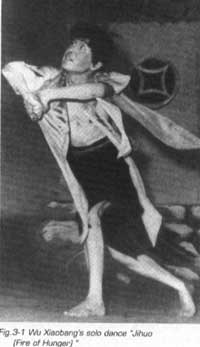EXCEPTS FROM CHINESE DANCE
by Sun Jingchen, Luo Xiongyan, Zi Huayun
Wu Xiaobang
Enthusiastic and Devoted to Dances
WU Xiaobang (1906-1995) was a pioneer and seed sower of modern Chinese dances.
When he was born, Western dances were just introduced into China. The introduction was done by YU Rongling (1882-1973), daughter of an official in the late Qing Dynasty She traveled abroad with her father and learned dancing from lsadora Duncan. Back to China, she began to perform in the court and was favored by Dowager Cixi. In her later practices of western dances, she used her personal creation.
At the beginning of the century, the Chinese students studying abroad wrote books about the West and particularly about its folk customs including dance.
Besides, dance in European and American movies and those taught by foreigners attracted a lot of enlightened Chinese. They showed a special interest in Western social dance.
In promoting a new teaching system, school and children dances were prospering, of which the most influential one was Li jinhui's children dance and the Mingyue (Bright Moon) Troupe set up later.
At the same time, we cannot deny the creation and development at the hands of opera masters. Four famous male characters of Peking Opera included Mei Lanfang all created beautiful dance segments worth spreading. Ouyang Yuqian, who was an expert in Peking Opera and modern arts, also contributed a lot to the renovation of traditional dance.
All the above helped the modern Chinese dance remold its features. Wu Xiaobang was unique. As a professional dancer, he struggled his whole life to perfect dance and linked his life closely with the fate of the nation.
Born into a well-off family, Wu Xiaobang went to Japan to study when he was young. A Japanese dance drama "Group Ghosts", disclosing the darkness and evil of society, shocked him greatly Since then, he devoted himself to dance. His decision had many similarities with Chinese literati Lu Xun, who gave up medical sciences and dedicated himself to literature. Both of them were idealistic and showed great concern for their country.
From 1929 to 1932, he went to Japan three times and learned ballet and modern dance from Masao Takada, Tacaya Eguchi and Misako Miya. Not constrained by his teachers, Wu paid much attention to the scientific training of bodies. He also attached great importance to the study of traditional arts and national Culture. When he came back, he established a dance school in Shanghai and held two exhibitions respectively in 1935 and 1937. His major dancing programs included "Puppet", "Funeral Procession", "Little Clown", "Night of the Pujiang River" and "Yearning for Peace", which directly reflected social reality. His advocacy of dancing for life", like a cool breeze, lashed against the pornographic and poor taste dance styles flooding Shanghai at that time.
During the Anti-Japanese War, Wu Xiaobang stepped out of his own ivory tower of arts and plunged himself into the national liberation movement. During this period, he passed through many places and composed nearly 100 timely and inspiring works to fight against fascism and feudal ethics and arouse common people.
Typical representative pieces of Wu during that period included the solo dance "March of the Volunteers" in 1937 produced from a song of the same title by Nie Er and the group dance "Song of the Guerrillas" in 1938 produced from a song of the same title by He Luting. Audiences at each performance were excited and shared a bitter hatred of the enemy As he wrote in his memoirs, "Only when a man is filled with enthusiasm and devotedness, can he get such a magical power".
 In 1945, with the support of Premier Zhou Enlai, he and his wife ShengJie (also a dancer) went to Yan'an and later to other places with the army. He became braver as a soldier and more sensitive as an artist. In 1942, he produced and performed "jihuo (Fire of Hunger)", emphatically demonstrating the burning body and shouts of the soul, which shocked the audience. (Fig.3-1)
In 1945, with the support of Premier Zhou Enlai, he and his wife ShengJie (also a dancer) went to Yan'an and later to other places with the army. He became braver as a soldier and more sensitive as an artist. In 1942, he produced and performed "jihuo (Fire of Hunger)", emphatically demonstrating the burning body and shouts of the soul, which shocked the audience. (Fig.3-1)
In 1994, "Song of the Guerrillas" and "jihuo" were confirmed as Dance Classics of the Chinese Nation in the 20th century.
On the foun-dation of the People's Republic of China, Wu Xiaobang mainly devoted himself to teaching theoretical study and art management. In the 1960s, he set up the "Tianma Dance Art Studio" combining teaching, producing and performing into one and dedicated himself to the exploration of Chinese modern dance and new classical dance. In the 1980s, he started the first Dance Department in the Chinese Academy of Art, which endows master's or doctor's degrees in dance. He also published many articles talking about dance science. Wu is generally recognized as a master of the modem Chinese dance.
